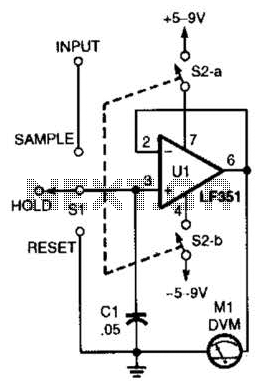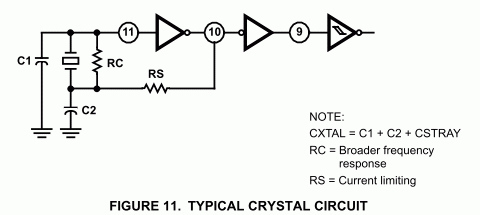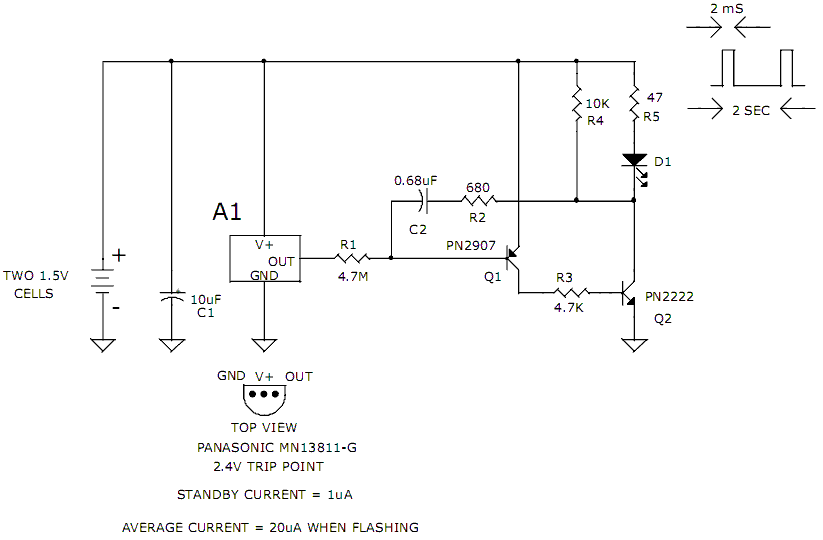
4 i n 1 burglar alarm circuit diagram

In this circuit, the alarm is activated under four different conditions: 1. When light falls on LDR1 (located at the entry to the premises). 2. When light falling on LDR2 is obstructed. 3. When door switches are opened or a wire is broken. 4. When a handle is touched. The light-dependent resistor LDR1 should be placed in darkness near the door lock or handle. If an intruder shines a torch, the light will fall on LDR1, reducing the voltage drop across it and consequently the voltage applied to trigger 1 (pin 6) of IC1. This causes transistor T2 to become forward biased, energizing relay RL1 to activate the alarm. The sensitivity of LDR1 can be adjusted by varying preset VR1. LDR2 may be positioned on one side of a corridor such that a beam of light from a light source consistently illuminates it. When an intruder passes through the corridor, their shadow falls on LDR2, increasing the voltage drop across it, which causes pin 8 of IC1 to go low while output pin 9 of IC1 goes high. Transistor T2 is then switched on, and the relay operates to set off the alarm. The sensitivity of LDR2 can be adjusted using potentiometer VR2. A long, thin wire can be connected between points A and B or C and D across a window or door. This wire can also be used to lock or tie something. If anyone cuts or breaks this wire, the alarm will be triggered as pin 8 or 6 will go low. Alternatively, door switches can be connected between these points. These switches should be mounted on the door so that when the door is closed, the switch is closed, and when the door is open, the switch remains open. If the switches or wire are not used between these points, they should be shorted. A wire should connect the touch point (P) to the handle of a door or another suitable conductive object. When this handle or object is touched, pin 6 of IC1 goes low, activating the alarm and relay. The object connected to this touch point must be well insulated from the ground. For effective touch action, potentiometer VR3 should be properly adjusted. If the tapping of potentiometer VR3 is closer to ground, the alarm may trigger even without touching. In such cases, the tapping should be raised, but not excessively, as this would eliminate touch action. When adjusting potentiometer VR1, it is essential to re-adjust the sensitivity of the touch point using potentiometer VR3. If the alarm has a voltage rating other than 6V (more than 6V) or requires a high current (more than 150 mA), it should be connected through the relay points as indicated by the dotted lines. For optimal performance as a burglar alarm, a battery backup is necessary for this circuit. Note: Electric sparking near this circuit may cause false triggering; thus, potentiometer VR3 should be adjusted appropriately.
This circuit functions as a comprehensive alarm system utilizing light-dependent resistors (LDRs) and a microcontroller (IC1) to detect unauthorized access. The system is designed to activate an alarm under specific conditions, ensuring robust security for the premises.
The circuit employs two LDRs, LDR1 and LDR2, which serve as primary sensors. LDR1 is strategically placed in a dark location near the door lock or handle, while LDR2 is positioned to detect interruptions in a light beam across a corridor. The operation of the alarm is contingent upon the changes in resistance of these LDRs, which directly influence the voltage levels at the input pins of IC1. When LDR1 detects light from a torch, its resistance decreases, leading to a drop in voltage at pin 6 of IC1, triggering the alarm via transistor T2 and relay RL1.
LDR2 operates similarly; it is kept illuminated by a constant light source. An intruder blocking this light source will cause an increase in resistance, resulting in a low signal at pin 8 of IC1, which also activates the alarm. The sensitivity of both LDRs can be finely tuned using the respective variable resistors (VR1 and VR2), allowing for customization based on the installation environment.
The circuit also incorporates a wire or door switches as additional security measures. The wire, connected between designated points, acts as a tripwire; when severed, it sends a low signal to the relevant pins on IC1, activating the alarm. Door switches serve a similar purpose, ensuring the alarm is triggered when doors are opened.
A touch point is included in the design, allowing the alarm to be activated by simply touching a conductive object connected to point P. This feature enhances the circuit's security capabilities, as it can be triggered by unexpected contact.
For optimal performance, especially in environments prone to electrical interference, careful calibration of potentiometer VR3 is necessary to prevent false alarms. The circuit is designed to accommodate alarms with varying voltage and current ratings, ensuring versatility in its application.
Overall, this alarm circuit is a sophisticated solution for enhancing security, integrating multiple triggering mechanisms, and providing adjustable sensitivity for reliable operation.I n this circuit, the alarm will be switched on under the following four different conditions: 1. When light falls on LDR1 (at the entry to the premises). 2. When light falling on LDR2 is obstructed. 3. When door switches are opened or a wire is broken. 4. When a handle is touched. The light dependent resistor LDR1 should be placed in darkness nea r the door lock or handle etc. If an intruder flashes his torch, its light will fall on LDR1, reducing the voltage drop across it and so also the voltage applied to trigger 1 (pin 6) of IC1. Thus transistor T2 will get forward biased and relay RL1 energise and operate the alarm. Sensitivity of LDR1 can be adjusted by varying preset VR1. LDR2 may be placed on one side of a corridor such that the beam of light from a light source always falls on it.
When an intruder passes through the corridor, his shadow falls on LDR2. As a result voltage drop across LDR2 increases and pin 8 of IC1 goes low while output pin 9 of IC1 goes high. Transistor T2 gets switched on and the relay operates to set the alarm. The sensitivity of LDR2 can be adjusted by varying potentiometer VR2. A long but very thin wire may be connected between the points A and B or C and D across a window or a door.
This long wire may even be used to lock or tie something. If anyone cuts or breaks this wire, the alarm will be switched on as pin 8 or 6 will go low. In place of the wire between points A and B or C and D door switches can be connected. These switches should be fixed on the door in such a way that when the door is closed the switch gets closed and when the door is open the switch remains open. If the switches or wire, are not used between these points, the points should be shorted. With the help of a wire, connect the touch point (P) with the handle of a door or some other suitable object made of conducting material.
When one touches this handle or the other connected object, pin 6 of IC1 goes low`. So the alarm and the relay gets switched on. Remember that the object connected to this touch point should be well insulated from ground. For good touch action, potentiometer VR3 should be properly adjusted. If potentiometer VR3 tapping is held more towards ground, the alarm will get switched on even without touching. In such a situation, the tapping should be raised. But the tapping point should not be raised too much as the touch action would then vanish. When you vary potentiometer VR1, re-adjust the sensitivity of the touch point with the help of potentiometer VR3 properly.
If the alarm has a voltage rating of other than 6V (more than 6V), or if it draws a high current (more than 150 mA), connect it through the relay points as shown by the dotted lines. As a burglar alarm, battery backup is necessary for this circuit. Note: Electric sparking in the vicinity of this circuit may cause false triggering of the circuit. To avoid this adjust potentiometer VR3 properly. Disclaimer: All the information present on this site are for personal use only. No commercial use is permitted without the prior permission from authors of this website. All content on this site is provided as is and without any guarantee on any kind, implied or otherwise.
We cannot be held responsible for any errors, omissions, or damages arising out of use of information available on this web site. The content in this site may contain COPYRIGHTED information and should not be reproduced in any way without prior permission from the authors.
🔗 External reference
This circuit functions as a comprehensive alarm system utilizing light-dependent resistors (LDRs) and a microcontroller (IC1) to detect unauthorized access. The system is designed to activate an alarm under specific conditions, ensuring robust security for the premises.
The circuit employs two LDRs, LDR1 and LDR2, which serve as primary sensors. LDR1 is strategically placed in a dark location near the door lock or handle, while LDR2 is positioned to detect interruptions in a light beam across a corridor. The operation of the alarm is contingent upon the changes in resistance of these LDRs, which directly influence the voltage levels at the input pins of IC1. When LDR1 detects light from a torch, its resistance decreases, leading to a drop in voltage at pin 6 of IC1, triggering the alarm via transistor T2 and relay RL1.
LDR2 operates similarly; it is kept illuminated by a constant light source. An intruder blocking this light source will cause an increase in resistance, resulting in a low signal at pin 8 of IC1, which also activates the alarm. The sensitivity of both LDRs can be finely tuned using the respective variable resistors (VR1 and VR2), allowing for customization based on the installation environment.
The circuit also incorporates a wire or door switches as additional security measures. The wire, connected between designated points, acts as a tripwire; when severed, it sends a low signal to the relevant pins on IC1, activating the alarm. Door switches serve a similar purpose, ensuring the alarm is triggered when doors are opened.
A touch point is included in the design, allowing the alarm to be activated by simply touching a conductive object connected to point P. This feature enhances the circuit's security capabilities, as it can be triggered by unexpected contact.
For optimal performance, especially in environments prone to electrical interference, careful calibration of potentiometer VR3 is necessary to prevent false alarms. The circuit is designed to accommodate alarms with varying voltage and current ratings, ensuring versatility in its application.
Overall, this alarm circuit is a sophisticated solution for enhancing security, integrating multiple triggering mechanisms, and providing adjustable sensitivity for reliable operation.I n this circuit, the alarm will be switched on under the following four different conditions: 1. When light falls on LDR1 (at the entry to the premises). 2. When light falling on LDR2 is obstructed. 3. When door switches are opened or a wire is broken. 4. When a handle is touched. The light dependent resistor LDR1 should be placed in darkness nea r the door lock or handle etc. If an intruder flashes his torch, its light will fall on LDR1, reducing the voltage drop across it and so also the voltage applied to trigger 1 (pin 6) of IC1. Thus transistor T2 will get forward biased and relay RL1 energise and operate the alarm. Sensitivity of LDR1 can be adjusted by varying preset VR1. LDR2 may be placed on one side of a corridor such that the beam of light from a light source always falls on it.
When an intruder passes through the corridor, his shadow falls on LDR2. As a result voltage drop across LDR2 increases and pin 8 of IC1 goes low while output pin 9 of IC1 goes high. Transistor T2 gets switched on and the relay operates to set the alarm. The sensitivity of LDR2 can be adjusted by varying potentiometer VR2. A long but very thin wire may be connected between the points A and B or C and D across a window or a door.
This long wire may even be used to lock or tie something. If anyone cuts or breaks this wire, the alarm will be switched on as pin 8 or 6 will go low. In place of the wire between points A and B or C and D door switches can be connected. These switches should be fixed on the door in such a way that when the door is closed the switch gets closed and when the door is open the switch remains open. If the switches or wire, are not used between these points, the points should be shorted. With the help of a wire, connect the touch point (P) with the handle of a door or some other suitable object made of conducting material.
When one touches this handle or the other connected object, pin 6 of IC1 goes low`. So the alarm and the relay gets switched on. Remember that the object connected to this touch point should be well insulated from ground. For good touch action, potentiometer VR3 should be properly adjusted. If potentiometer VR3 tapping is held more towards ground, the alarm will get switched on even without touching. In such a situation, the tapping should be raised. But the tapping point should not be raised too much as the touch action would then vanish. When you vary potentiometer VR1, re-adjust the sensitivity of the touch point with the help of potentiometer VR3 properly.
If the alarm has a voltage rating of other than 6V (more than 6V), or if it draws a high current (more than 150 mA), connect it through the relay points as shown by the dotted lines. As a burglar alarm, battery backup is necessary for this circuit. Note: Electric sparking in the vicinity of this circuit may cause false triggering of the circuit. To avoid this adjust potentiometer VR3 properly. Disclaimer: All the information present on this site are for personal use only. No commercial use is permitted without the prior permission from authors of this website. All content on this site is provided as is and without any guarantee on any kind, implied or otherwise.
We cannot be held responsible for any errors, omissions, or damages arising out of use of information available on this web site. The content in this site may contain COPYRIGHTED information and should not be reproduced in any way without prior permission from the authors.
🔗 External reference




